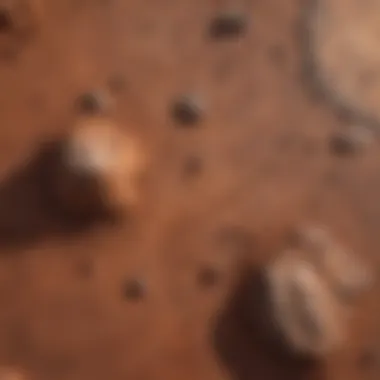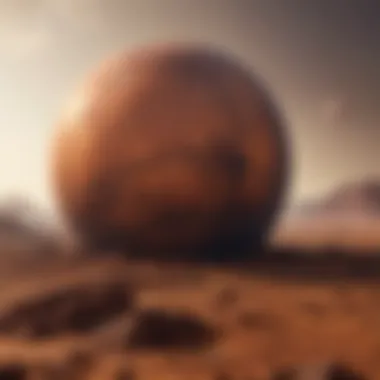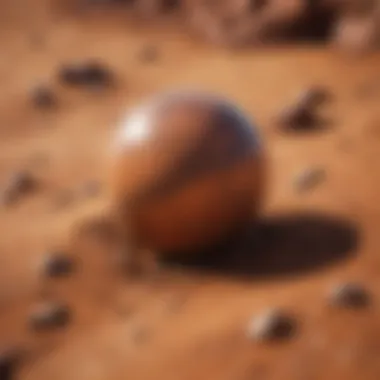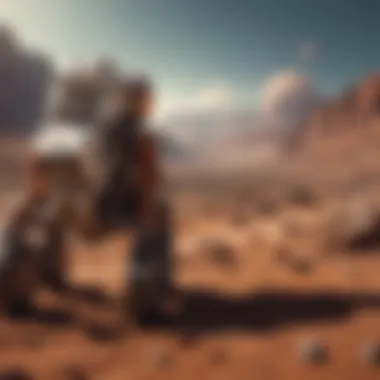Exploring Mars: Its Mysteries and Astrological Insights


Intro
Mars, the fourth planet from the Sun, holds a unique position both in astronomy and astrology. Known as the Red Planet due to its reddish appearance, Mars has sparked human curiosity for centuries. This article aims to provide insights into Mars’s physical attributes, geological history, and atmospheric conditions, while also exploring its influence within the zodiac and astrology.
In the realm of astrology, Mars takes on significant roles in influencing personality traits and behaviors. The interplay between Mars and other celestial bodies can provide valuable insights into human interactions and personal growth. Understanding Mars not only enhances our knowledge of the universe but also our understanding of ourselves.
Zodiac Sign Overview
General Traits and Characteristics
Mars is often associated with traits such as ambition, aggression, and passion. Those influenced by Mars tend to be assertive and courageous, often exhibiting a pioneering spirit. The planet symbolizes energy and drive, motivating individuals to pursue their goals with determination. Of note is the duality in Mars's nature; while it fosters initiative and leadership, it can also amplify conflicts and impulsive behaviors.
Elemental Associations
Mars corresponds to the element of Fire. This association suggests a connection to creativity, enthusiasm, and inspiration. Fire signs, like Aries and Leo, exemplify the dynamism that Mars brings. This element is not only representative of passion but also embodies the transformative aspects of actions and decisions.
Ruling Planets
In astrology, Mars rules over the signs of Aries and Scorpio. Each of these signs embodies distinctive qualities attributed to Mars. Aries, as the first sign of the zodiac, reflects pioneering action, while Scorpio delves into deeper emotional and transformative matters.
Intro to Mars
Mars, often recognized by its reddish hue, has fascinated humans for centuries. This article will delve deep into the essence of Mars, unraveling its mysteries and significance across various domains, particularly in astronomy and astrology.
The importance of studying Mars lies in its potential to reshape our understanding of the universe and our place within it. By examining its physical characteristics, atmosphere, and geological history, we gain insights into planetary formation and evolution. Moreover, studying Mars plays a critical role in our quest to understand the possibilities of life beyond Earth.
Why Study Mars?
The motivations to study Mars extend beyond mere curiosity. Here are a few compelling reasons:
- Comparative Planetology: By analyzing Mars, scientists can compare it to Earth and other celestial bodies, enriching our understanding of planetary processes.
- Life’s Origins: Mars holds clues about the potential for life elsewhere in the universe. Investigating its past may help us elucidate how life forms arise.
- Space Exploration: Understanding Mars is crucial for future human exploration. Knowledge of its environment, resources, and challenges will guide mission planning.
- Cultural Significance: Historically, Mars has been relevant in both scientific and astrological contexts, influencing arts and perceptions of our own world.
In summary, Mars is not just a distant planet; it is a gateway to understanding our cosmos better. Studying Mars offers a multitude of benefits, shaping both scientific inquiry and human imagination.
Physical Characteristics of Mars
The study of Mars’ physical characteristics is essential for understanding the planet's nature, its history, and its potential for future exploration. These factors play a critical role in gaining insight into Martian terrain, geology, and the processes that have shaped its surface. By examining these elements, scientists can ascertain Mars's similarities and differences in comparison to Earth, which aids in the quest for life forms and informs future manned missions. Understanding the physical characteristics also addresses broader questions about the potential for human colonization and long-term habitation.
Size and Composition
Mars has a diameter of about 6,779 kilometers, making it the second smallest planet in our solar system. Its mass is roughly 0.11 times that of Earth. The composition of Mars primarily includes iron, magnesium, aluminum, calcium, and potassium. This mineralogical make-up contributes to Mars's distinctive red color, which is a result of iron oxide, commonly known as rust. The thin crust consists of basaltic rock, similar to the Earth’s oceanic crust but richer in certain elements such as sulfur. Understanding Mars's size and composition not only provides insight into its geological past but also helps determine the feasibility of resource utilization in future missions.
Surface Features
Surface features on Mars are diverse and provide evidence of geological processes that have occurred over billions of years. Some key features include:
- Volcanoes: Mars is home to the largest volcano in the solar system, Olympus Mons, which stands about 22 kilometers high and spans 600 kilometers in diameter. The caldera contains several smaller craters, indicating several phases of activity. Such features are vital for understanding volcanic activity and tectonics on Mars.
- Canyons: The Valles Marineris canyon system is one of the most significant surface features. It stretches over 4,000 kilometers and presents insights into potential past water flow and geological activity. Its sheer size and depth make it a fascinating area of study, as it reveals information about Martian erosion and tectonic history.
- Polar Ice Caps: Mars hosts two polar ice caps that consist primarily of water ice and dry ice. Their seasonal changes provide data on the planet's climatic conditions and atmospheric processes. Investigating these ice caps can lead to discoveries about the history of water on Mars, which is crucial for discussions on habitability.


- Volcanoes contribute essential information about the interior processes of Mars and its geological evolution. Their large scale provides an opportunity to study volcanic activity in a different planetary context.
- Canyons serve as proof of past geological events, offering clues about past water presence and erosion in the Martian environment.
- Polar Ice Caps are indicators of climate variability and play a role in the broader understanding of Martian weather and its potential to support life.
Geological History
Understanding the geological history of Mars requires an exploration of its formation and age, alongside erosional processes that have shaped its landscape over time.
Formation and Age
Mars is believed to have formed approximately 4.6 billion years ago, around the same time as the solar system. Studying the age of Martian rocks and soil provides insight into the early conditions of the planet, contributing to our understanding of its evolution. The presence of ancient river valleys and lake beds indicates that Mars may have once had conditions suitable for life.
Erosional Processes
Erosion on Mars, primarily driven by wind and, to a lesser extent, water, has significantly impacted the landscape. Unique features, like dust storms, can reshape the surface, influencing future exploration strategies. Erosion also plays a role in analyzing the planet's climate history, as sediment layers provide clues to past environments. Understanding these processes helps ascertain the stability of the Martian surface for future missions.
These physical characteristics of Mars provide invaluable context for exploring the planet's past and its potential to support life. The data gathered will assist in crafting future exploration missions, enhancing our understanding of not just Mars but planetary processes as a whole.
Mars' Atmosphere
Mars' atmosphere plays a crucial role in understanding the planet as a whole, influencing its climate, potential for life, and even future exploration. With a thin atmosphere comprised mainly of carbon dioxide, the conditions on Mars differ dramatically from those on Earth. Studying the composition, weather patterns, and climate variability of Mars provides insight into its past and future.
Composition
The atmosphere of Mars is roughly 95% carbon dioxide, with traces of nitrogen, argon, and oxygen making up the rest. This distinct balance results in a very thin atmosphere, with a surface pressure less than 1% that of Earth. The presence of carbon dioxide suggests that the planet once may have had a more substantial atmosphere, possibly enabling liquid water to exist on its surface. In addition to carbon dioxide, seasonal atmospheric phenomena occur as water vapor and dust particles interact.
A thin atmosphere means that Mars cannot effectively trap heat, causing significant temperature fluctuations between day and night.
Weather Patterns
Mars experiences unique weather patterns that differ from those on Earth. Dust storms are common on the Martian surface, sometimes enveloping the entire planet and creating unpredictable visibility conditions. The atmosphere also allows the formation of clouds, mainly composed of carbon dioxide frost and water ice. These clouds can sometimes lead to precipitation, albeit in the form of frost rather than rain. The average temperatures on Mars range from -80 degrees Fahrenheit (-60 degrees Celsius) at the poles to around 70 degrees Fahrenheit (20 degrees Celsius) at the equator during the summer months. The irregularity of the weather patterns makes it difficult for scientists to predict conditions during exploration missions.
Climate Variability
Climate on Mars shows variability over geological time scales. Evidence suggests that Mars has undergone significant climate changes, possibly influenced by its axial tilt and orbit over millions of years. The current climate is predominantly cold and dry, but there are indications of a more dynamic past, possibly with warmer and wetter conditions. The seasonal changes impact surface features, leading to the cycling of ice deposits and influencing how we interpret future conditions conducive to life. Understanding these variations in climate is essential for developing future exploration strategies.
By examining the atmosphere of Mars, we gain critical insights into both its potential for supporting life and its historical evolution. The data gathered not only informs scientists but also serves those interested in understanding the astrological significance Mars holds in various practices.
Potential for Life on Mars
The question of life on Mars is one of the most compelling aspects of planetary science. Understanding the potential for life on Mars sheds light not just on our neighboring planet, but also on the possibilities of life beyond Earth. Many scientists consider Mars to be the most habitable planet in our solar system, aside from Earth. This notion ignites curiosity and drives exploration efforts.
Historical Search for Life
For decades, the search for life on Mars has captivated scientists and the public alike. Early missions, like Mariner 4 in 1965, were primarily focused on surveying the planet's surface and atmosphere. The 1976 Viking landers were groundbreaking. They conducted experiments with the goal of detecting signs of life. They found ambiguous results that still fuel debate today. Many researchers believe that the Martian environment, especially in the ancient past, may have been much more suitable for life than it is today. Evidence suggests that rivers and lakes once existed on Mars, which creates an appealing backdrop for potential microbial life.
Current Research Findings
In recent years, missions such as Curiosity and Perseverance have provided invaluable insights into the habitability of Mars. Discoveries of organic molecules and seasonal methane emissions hint at biological processes, perhaps of the past. Furthermore, Perseverance's exploration in Jezero Crater shows signs of ancient river deltas, presenting favorable conditions for microbial habitats. These findings are essential in painting a picture of Mars as once a dynamic environment capable of sustaining life. The search is ongoing, and each new discovery pushes the boundaries of what is possible.
Future Exploration Goals


The future of Martian exploration is ambitious. NASA and other space agencies have outlined plans for sending humans to Mars by the 2030s. These missions aim to conduct in-situ research and possibly return samples to Earth. Moreover, there are interests in utilizing local resources, as astrobiology experts look for biosignatures that directly indicate the past or present existence of life. One important aspect is the exploration of subsurface environments, as they might harbor conditions where life could exist, safe from harsh surface conditions.
“The search for life on Mars is not merely about finding organisms; it is about understanding the origins of life itself.”
This quest not only raises important scientific questions but also reframes humanity's place in the cosmos. As research continues, Mars holds the potential to unveil mysteries that may reshape our understanding of life itself.
Mars in Astrology
Understanding the astrological significance of Mars is essential for those who explore the influences celestial bodies have on human behavior and life events. Mars, known as the god of war in Roman mythology, embodies energy, aggression, and assertiveness. These traits extend into astrological readings, where Mars influences various aspects of personality and interpersonal dynamics. Analyzing its implications not only deepens the comprehension of individual astrological charts but also enhances broader astrological practices.
Mars and Zodiac Signs
Mars's influence varies depending on its position in the zodiac. Each zodiac sign interprets Mars's energy differently, affecting individuals born under those signs.
- Aries: Here, Mars is considered to be at home. The assertiveness and pioneering spirit are amplified, leading to high levels of ambition.
- Taurus: Mars in Taurus channels energy into persistence and determination, emphasizing an earthy approach to achieving goals.
- Gemini: The presence of Mars in Gemini stimulates curiosity and quick decision-making skills, often leading to a restless need for activity.
- Cancer: This placement often brings an emotional drive. Motivation may come from personal relationships and home life.
- Leo: Here, Mars gives a boost to creativity and leadership qualities, fostering confidence.
- Virgo: In Virgo, energies focus on practicality, meticulousness, and a desire to serve others.
- Libra: For Libra, Mars influences partnerships, motivating one to seek harmony and balance in relationships.
- Scorpio: Mars exudes strong influence in Scorpio, driving passion, intensity, and sometimes obsession.
- Sagittarius: This placement embodies a love for adventure and a restless spirit, seeking freedom.
- Capricorn: In Capricorn, Mars enhances responsibility and ambition, stabilizing energy for long-term goals.
- Aquarius: Mars in Aquarius promotes innovative thinking and a rebellious attitude towards traditions.
- Pisces: Here, Mars can often lead to escapism or a tendency to be influenced by emotions rather than rational thought.
Each sign presents unique manifestations of Mars’s assertive nature, shaping personal identities and behavioral traits.
Influence on Personal Traits
The influence of Mars on personal traits is profound, as it governs not just physical energy but also emotional dynamics. When analyzing a natal chart, Mars can provide insights into how individuals assert themselves and face challenges. A strong Mars can denote a competitive nature, while a weak position might indicate difficulty in expressing anger or taking initiative.
Furthermore, Mars also informs how people respond to conflict. A well-aspected Mars can yield constructive and courageous responses, while a poorly placed Mars can lead to aggression and impulsivity. Astrologers often look to this planet to engage with their client's conflicts and motivations.
Mars' Role in Relationships
In relationships, Mars plays a critical role in shaping dynamics between partners. It governs attraction and physical desires, impacting not only how individuals pursue romance but how they express passion. A person with a strong Mars placement may be more assertive and straightforward about their needs.
Conversely, aspects to Mars in synastry—comparing two natal charts—can reveal potential challenges. For instance, harmonious aspects can indicate a healthy, passionate connection, while afflictions may suggest power struggles or miscommunications. Such insights are invaluable for both personal growth and relationship compatibility assessments.
Understanding Mars in astrology provides clarity on motivation, aggression, and relationship patterns. Its influence shapes not only individual paths but also collective experiences.
In summary, Mars carries substantial weight in astrology. Its influences in zodiac signs, personal traits, and relationships offer important perspectives for those engaged in astrological studies and practices. By recognizing these nuances, astrologers can better understand the human experiences shaped by the red planet.
Mars Exploration Missions
Mars, as a focal point of astronomical exploration, commands interest for both its potential to host life and its status as a neighbor in our solar system. Studying Mars through various missions provides key insights into its geology, atmosphere, and possibly its past habitability. The exploration endeavors not only deepen our understanding of Mars itself but also enhance our grasp of planetary sciences and the conditions that could support life beyond Earth.
Historical Missions Overview
The exploration of Mars dates back several decades, with numerous missions paving the way for contemporary and future explorations. Each mission has its unique contributions and goals, marking new frontiers in Martian research. Among the landmark missions, NASA's Viking program in the 1970s remains notable. Viking 1 and Viking 2 conducted extensive surface analysis and imaging, forming foundational knowledge about Mars' soil and atmospheric conditions.
Later, the Mars Pathfinder mission brought a revolutionary approach in 1997 by employing a robotic rover, Sojourner, to explore the Martian terrain, providing direct data on rocks and soil characteristics. The Mars Global Surveyor, which orbited the planet from 1997 to 2006, further enriched our understanding of Mars through high-resolution mapping, revealing essential details about surface conditions and weather phenomena.
These historical missions serve as the backbone for today’s exploration and set the stage for improved technology and better understanding of Mars.
Recent Advances in Technology


Technology plays a pivotal role in Mars exploration, as it enables more intricate and capable missions. Over the years, the development of advanced instruments has transformed how information is collected and analyzed. For instance, the introduction of more robust sensors and cameras onboard Mars rovers allows for detailed imaging and soil composition analysis.
The entry, descent, and landing technologies have also evolved. The use of innovative landing techniques, such as the sky crane method used by NASA's Curiosity rover, ensures safer and more precise landings on this hostile terrain. Moreover, the capability of real-time data transmission has greatly increased the efficiency of mission operations, allowing scientists to analyze findings almost instantaneously.
Automation has emerged as a critical factor for Mars missions, with autonomous navigation systems on rovers facilitating exploration across diverse landscapes. These advancements are crucial for upcoming missions and play a significant role in understanding Mars in a more profound way.
Notable Current Missions
Presently, Mars hosts several notable missions aimed at unraveling its mysteries. NASA's Perseverance rover, launched in July 2020, focuses on astrobiology and the search for signs of ancient life. Its sophisticated instruments can analyze the Martian surface samples and even collect soil for potential return to Earth.
In addition, the Mars Helicopter Ingenuity, which accompanies Perseverance, has achieved remarkable feats in aerial exploration, demonstrating the viability of powered flight in Mars’ thin atmosphere. This innovation opens new avenues for exploration, potentially allowing us to access areas that rovers cannot.
The United Arab Emirates' Hope orbiter remains another significant mission. It aims to study Mars' atmosphere and weather patterns, providing valuable data that contribute to both science and global perspectives on planetary atmospheres.
These missions not only push the boundaries of what we know about Mars but also resonate with interests beyond astronomy. They appeal to astrological inquiries, showing how human exploration of Mars intersects with broader cosmic understanding.
“The exploration of Mars is not just a scientific task; it is a quest for knowledge that connects humanity to the universe.”
Cultural Impact of Mars
The exploration of Mars extends beyond the parameters of science and technology; it also holds significant cultural relevance. The cultural impact of Mars encompasses the ways in which this planet has influenced literature, media, and the broader public's imagination. Understanding these cultural intersections offers insights into human behavior, creativity, and how we envision our place in the universe. The fascination with Mars reflects our collective curiosity about life beyond Earth and our own humanity.
Mars in Literature and Media
Mars has been a source of inspiration for countless authors and filmmakers. Classic science fiction works, such as Ray Bradbury's The Martian Chronicles, explore the themes of colonization, alien life, and the existential dilemmas of humanity. Other literary pieces often depict Mars as a setting for adventure and exploration, prompting readers to consider the possibilities of interplanetary life.
In cinema, films like Total Recall and The Martian portray human experience on Mars in very distinctive ways. They merge action and survival with deeper themes of isolation, identity, and adaptation. This carries great importance, particularly for those interested in astrology and the human experience. The portrayal of Mars in these narratives often ties back to its astrological symbolism, representing ambition, aggression, and desire.
The connection between Mars and literary themes reveals how the planet's image invigorates the imagination, driving both storytelling and creative expression.
Mars in Popular Culture
Mars occupies a prominent place in popular culture, influencing everything from video games to advertising. For instance, video games such as Doom and Red Faction have utilized Mars as a backdrop for exploring conflict and strategy, reinforcing its image as a battleground. This reflects an interest in the potential for human expansion into space and the conflicts that might arise.
Moreover, Mars-themed merchandise—from toys to apparel—demonstrates how societal fascination translates into consumer culture. This extends to art and music, where artists harness the imagery of Mars to evoke themes of futurism and exploration.
Notably, the rover missions have also notably sparked public interest. NASA's Perseverance has generated significant media coverage, prompting discussions about the future of space exploration and our relationship with the cosmos.
Exploring Mars serves not just as scientific inquiry but as a means of cultural expression that shapes and mirrors human hope and anxiety.
The Ends and Future Prospects
The exploration and understanding of Mars have significant implications for multiple fields. Mars serves as a crucial model for comparative planetology, shedding light on planetary evolution and climate change. The knowledge gained from studying Mars can inform our understanding of Earth and the potential for life beyond our own planet.
Understanding Mars is fundamental for future exploratory missions. With technology evolving rapidly, the possibility of human presence on Mars is not a distant dream. This makes it vital to prioritize research on the planet's environmental conditions, resources, and potential hazards. Such investigations can ultimately pave the way for sustainable human colonization, supporting scientific endeavors that may help solve some Earth's pressing issues.
If we want to reach other planets, we must learn all we can about exploring Mars.
Moreover, analyzing Mars's geological history offers insights into the processes that shape planetary bodies. These findings have relevance in not only understanding Mars but also applying that knowledge in broader astrological and esoteric contexts. For astrologers and esotericists, Mars's influence goes beyond physical characteristics–its positional dynamics can reveal deep connections to human behavior and relationships.
Summarizing Key Points
- Mars as a Model: The study of Mars helps compare its environment and history with Earth.
- Future Exploration: Advancements in technology lead to prospects of human missions on Mars.
- Environmental Research: Critical for safe and sustainable living conditions should missions succeed.
- Geological Insights: Understanding Mars's features allows for better comprehension of planetary processes.
- Astrological Relevance: Mars holds significance in astrology, influencing interpretations of personal traits and behaviors.
In summary, the pursuit of knowledge about Mars has multifaceted benefits, spanning scientific, exploratory, and astrological realms. The future of Mars exploration promises to unveil mysteries not only about the red planet itself but also about our existence and evolution in the universe.



